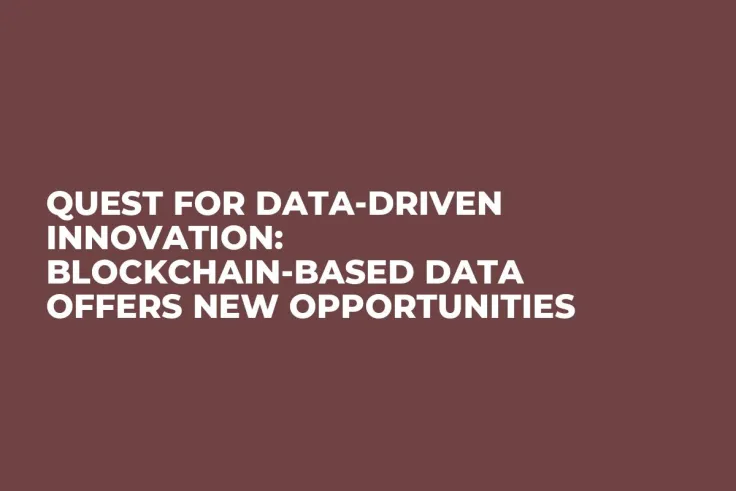
Disclaimer: The opinions expressed by our writers are their own and do not represent the views of U.Today. The financial and market information provided on U.Today is intended for informational purposes only. U.Today is not liable for any financial losses incurred while trading cryptocurrencies. Conduct your own research by contacting financial experts before making any investment decisions. We believe that all content is accurate as of the date of publication, but certain offers mentioned may no longer be available.
For nearly a decade now, the core principles pervading the blockchain ecosystem have promised to revamp many industries. However, beyond areas like crypto-finance and non-fungible tokens (NFTs), limited practical applications have emerged in recent years, restricting the technology’s widespread adoption.
Crypto economics meets data segment
This disconnect between blockchain's theoretical potential and its real-world implementation stems from a fundamental challenge: the need for more usable data within blockchain ecosystems.
To this point, developers are finding it increasingly difficult to conceive and demonstrate compelling use cases due to the limited availability of on-chain data. This data drought has not only stifled creativity but hindered the development of quality decentralized applications (dApps) whose utility extends beyond the world of finance.
Further compounding the matter is the relative immaturity of blockchain technology. With evolving infrastructure, tools, and best practices, enterprises are still understandably hesitant to build mission-critical systems on what they perceive as unstable ground.
This caution, while prudent, has created a barrier to the very adoption that could accelerate blockchain's maturation.
Reimagining the use of data in the context of Web3
To truly comprehend blockchain's transformative potential in optimal data utilization, examining how data brokers and Web2 applications currently leverage user information is important.
For instance, targeted marketing practices powered by detailed consumer profiles allow businesses to reach specific demographics with tailored campaigns, improving conversion rates and reducing ad waste.
Similarly, financial institutions routinely use data broker information to assess creditworthiness, streamlining loan approvals and minimizing default risks. Lastly, consumer-driven data insights are routinely used in healthcare to drive improvements in patient care and public health initiatives.
Web2 applications have similarly harnessed user data to enhance their services. Platforms like Netflix and Spotify employ sophisticated recommendation algorithms to personalize content, boosting user engagement and satisfaction.
That said, when it comes to the world of Web3, the potential to take these use cases even further is present, especially in addressing some of the fundamental concerns associated with centralized data control. To elaborate, Web3 empowers users to maintain ownership of their data, deciding what to share and with whom. Moreover, it opens the door to incentivized data sharing, where users are rewarded for contributing their information to the ecosystem.
Flare solves old problems in novel ways
In this regard, platforms like the Flare Network have emerged as potential game-changers as they help address blockchain’s data scarcity quandary. Flare's architecture is designed to provide data as a public good, ensuring that centralized entities do not control the information.
To begin with, the network's oracles, the Flare Time-Series Oracle (FTSO) and the State Connector, enable efficient access to large amounts of data and data proofs at minimal cost — thereby empowering developers to build software that can leverage a broad spectrum of trustless data, potentially catalyzing innovation across various sectors.
Furthermore, Flare's LayerCake protocol exemplifies the potential for cross-chain functionality, solving two major problems in the cryptocurrency world: ie. interoperability and cross-chain composability.
The protocol rethinks how users interact with different blockchain ecosystems, enabling seamless asset transfers while opening up new avenues for decentralized application (dApp) development.
The implications of Flare's approach are far-reaching. For instance, in the realm of DeFi, Flare's data-rich environment could enable more sophisticated financial products and risk assessment models.
Similarly, gaming applications too can benefit from cross-chain interoperability, allowing players to use assets across different blockchain ecosystems seamlessly. Lastly, the network's ability to provide verifiable, non-changing data from other chains and the internet opens up possibilities for creating more robust and diverse NFT ecosystems and innovative applications in music, social networks, and even artificial intelligence.
Finding pertinent data to drive blockchain innovation
As evidenced above, even though blockchain-based data comes with its fair share of opportunities, the challenges surrounding it — such as finding and developing relevant, high-quality data sets — can no longer be ignored.
In this broader context, projects like the Flare Network, which are helping curate data sets (that are abundant and relevant to real-world problems), are helping foster collaboration between blockchain developers, data scientists, and industry experts to identify key data points that can fuel innovative applications.
Therefore, looking ahead, it will be interesting to see how this space continues to evolve and grow.
 Arman Shirinyan
Arman Shirinyan Dan Burgin
Dan Burgin Caroline Amosun
Caroline Amosun Alex Dovbnya
Alex Dovbnya